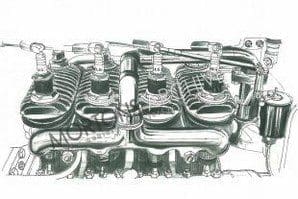
FN’s first motor cycle was produced in 1902. A 133cc single, it was successful enough to convince the factory that there was a future in two-wheelers. The following year the capacity was increased to 188cc, and in 1904 to 300cc. In charge of development was a young Belgian engineer, Paul Kelecom, and when a decision was taken, somewhere in the factory, to advance motor cycling’s cause by producing a four-cylinder machine, Kelecom was, naturally, put in charge of the project.
He set about the task with a will, and in a very short time, a prototype four cylinder motor cycle was being extensively tested. It was found to be very reliable, and as a final proving test, a development engineer named Osmont undertook a long trip around Europe. The new cycle came through without mechanical failure.
The FN Four was first publicly displayed at the Paris Show in 1905, and in the early part of that year production began at the factory in Herstal, Belgium. It was not the first four cylindered motor cycle, for in 1898 Colonel N.C. Holden had designed and built a watercooled 3hp four, of which a number were made, and a few survive.
Charles Binks, better known as a manufacturer of carburettors, also manufactured a four, from 1903 to 1906, with engines both in-line and transversely mounted. Laurin and Klement, the Austrian (later Czechoslovakian) company also made a four-in-line in 1905, but they stopped making motor cycles altogether in 1908.
First four cylindered motorcycle
The FN, then, can be regarded as the first four cylindered motor cycle that went into volume production over a long period. Above all, it was reliable. Part of its success must have lain in Kelecom’s grasp of the importance of adequate lubrication, for each of the con rods had a well of oil to dip into and splash around. In addition the crankshaft was supported on five main bearings, which was more than substantial by the standards of the time, and not equalled by some other very long-lived engines: BMC’s A-series, as used in Morris Minors amongst many other cars, only had three, for example.
The bore was 45mm and the stroke 75mm, giving a total capacity of 362cc. The exhaust valves were operated mechanically, but the inlets were atmospheric, relying on the depression inside the cylinder to open them and allow a fresh charge to pass in. If this was slightly primitive, the final drive was very advanced. In the age of belt-drive, Paul Kelecom opted for a totally enclosed shaft drive, with a bevel-and-pinion at the rear wheel. The cardan shaft ran down the inside of one of the rear frame tubes, a characteristic of BMW motor cycles to this day.
However, despite this advanced thinking, there was no provision for decoupling the engine – no clutch – and only a single speed.
Ancillary equipment had, naturally, to be as well designed and trustworthy as the engine and transmission. Kelecom took another step away from convention by specifying a magneto in place of the more usual – and more trouble-prone – battery and trembler coil ignition.
The FN Four was soon in demand all over the world. In 1908 there was a special model made for the American market, thus initiating a traditional sales boosting ploy. It did particularly well there as there was no other four cylinder motor cycle on the market at the time, and it can be credited with inspiring many American four cylinder designs, starting with the Pierce Arrow.
Recorded examples
It was not long before a gearbox was offered to complement the engine. The first recorded examples were designed by Sidney Horstmann in England, whose two-speed device replaced the standard cardan shaft. In 1910, FN offered the option of a clutch (or free engine, as it was known then) and a year later came up with their own two-speed gearbox.
Although capacity had been increased to 410cc in 1906, demand had been growing for a bigger machine, and in 1914 FN developed a 750cc motor with both inlet and exhaust valves operated mechanically, and disposed in a T-shape cylinder head. A three-speed gearbox and multiplate clutch were standard.
1914 is, of course, a year better known for other reasons, and when Germany invaded Belgium the FN factory – which was essentially an armaments concern was taken over and the heavyweight motor cycle pressed into service as a despatch riders’ machine. The smaller four cylinder model would never be made again, while the pioneering basis of the bigger bike was not developed to its full potential.
By 1923 sales had fallen away greatly, and a revamped, very American looking, overhead valve model was developed and built. Its main feature was really a retrograde step, for the shaft drive was dropped in favour of chain.
The new 750 never became very popular as it had fallen behind other motor cycles, particularly the American fours, in terms of performance and even basic equipment. The dynamo, for instance, was an optional extra, although electric lights were fitted. FN took the decision to cease manufacturing the Four in 1926, bringing to an end a chapter of motor cycling history.



